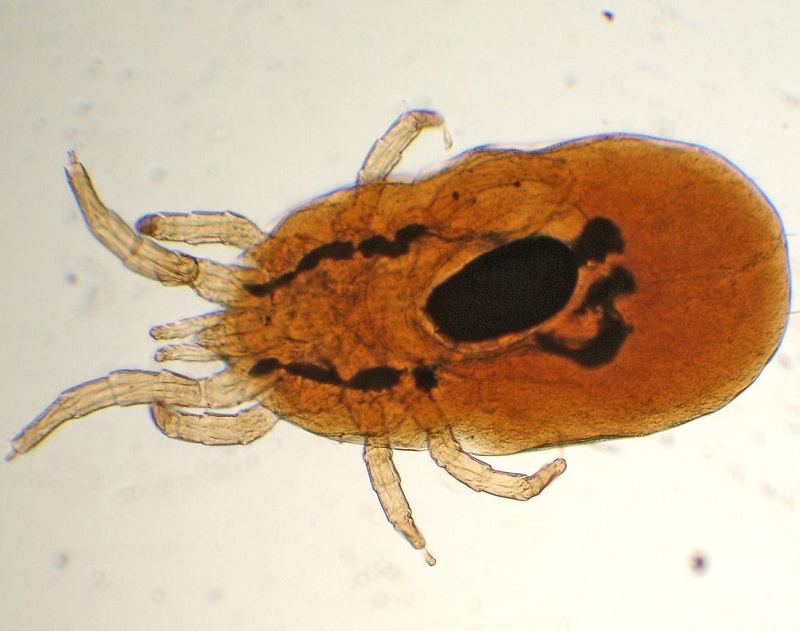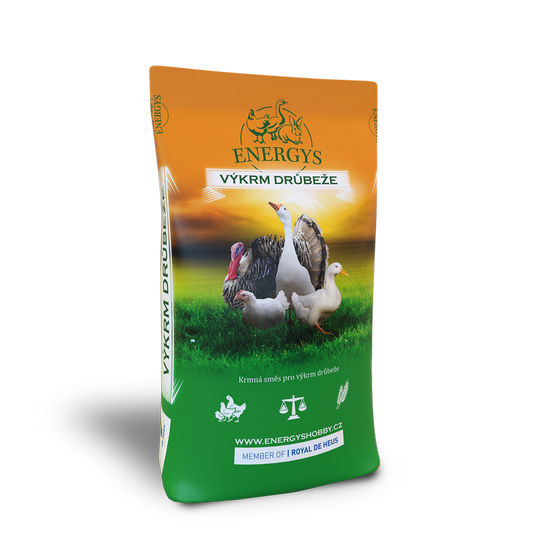Rabbits
Poultry
Laying hens
Quails
Guinea pigs
Pigs
Ostriches
Sheep and goats
Pigeons
Pheasants
Forest animals
How to deal with bumblebees in hens
The health of your hens is one of the most important things you should look after in your breeding. If a flock is lacking something or has a health problem, it will show up in a drop in laying or a change in behaviour. One such situation is an infestation of bumblebees. How do you identify and banish this parasite from the lives of your feathered friends?
Little creature, big pity
 The chicken bumblebee is no giant, but it can still do some serious damage. It is an exoparasite mite, 0.5 – 2 mm in size, living on the surface of the host’s body. If found, one hen can have up to 25,000 bumblebees in her feathers in a heavy infestation! However, bumblebees do not remain permanently in the feathers of hens because they are light-hungry. Most often they hide in the cracks of the henhouse during the day and go out to feed for a few hours at night. They then lay eggs in their hiding places, which hatch into larvae that can cause you big problems in the future.
The chicken bumblebee is no giant, but it can still do some serious damage. It is an exoparasite mite, 0.5 – 2 mm in size, living on the surface of the host’s body. If found, one hen can have up to 25,000 bumblebees in her feathers in a heavy infestation! However, bumblebees do not remain permanently in the feathers of hens because they are light-hungry. Most often they hide in the cracks of the henhouse during the day and go out to feed for a few hours at night. They then lay eggs in their hiding places, which hatch into larvae that can cause you big problems in the future.
The chicken bumblebee (dermanyssus gallinae) has 4 developmental stages besides the eggs: larva, protonymph, deutonymph and adult. The larvae hatch six-legged, blood-bearing. After the first pupation, nymphal stages and adults appear, always with eight limbs. Protonymphs, deutonymphs and adult females suck blood on the host, but males suck blood only occasionally. Larvae survive for up to 8 months. Blood drinking is required for egg laying.
To prevent bumblebees from infesting your entire henhouse, you must be alert and react in time.
Recognise the signs of an infestation early
You should be alert if your hens have changed their egg clutch. There may be a drop, a complete stop or you may find bloodstains on the eggs. You can also tell by their behaviour that something is wrong with the fledglings. They will be restless, weak and tired, and cannibalism may occur due to stress. As far as appearance is concerned, bumblebee attacks can be identified mainly by feather loss and significant weight loss.
Prevention is essential to protect your hens. This is a thorough inspection of the poultry (at least twice a week) and regular cleaning of the hen house. If you bring in new hens, also check them before releasing them.
Do you have bumblebees in your henhouse?
If you discover unfair bumblebee activity, take immediate action. The important thing is to dislodge the bloodthirsty creatures from their dwelling – the henhouse. The first step will be a thorough cleaning, including a mechanical washing with hot water and detergent. Pay attention to cracks, crevices, etc. Then follow up with the next step – most often using chemical or mechanical products to prevent the next generation of bumblebees from spreading. What are the appropriate ones?
An example of a mechanical preparation is silica – diatomaceous earth. This is a product that cleans out any gaps occupied by bumblebees. It mechanically wounds the limbs and seals the sucking and digestive tracts of the bumblebees. Wait for the hen house to dry after previous washing before applying it and never forget to wear protective gloves when using it. The advantage of diatomaceous earth is that resistance to it does not develop.
For chemical products, you can use a bumblebee spray that can be applied to the coop and other accessories. There are plenty of these sprays on the market, they are cheap, but they do develop resistance. As with diatomaceous earth, wait for the surfaces to dry and then spray into all joints, on the walls and on the ceiling of the coop. But definitely do not apply it directly to the hens!
Recently, exzolt has become very popular in commercial hen houses. It is an anti-parasitic agent administered in drinking water so that the animals are not exposed to stressful situations. It acts quickly, is safe and effective even on resistant bumblebee populations. After its use, a withdrawal period of 14 days must be observed for meat and offal; no withdrawal period is necessary for eggs.
We already have a clean coop, but what about treating the chickens?
The treatment of the hens is another task that awaits you in the fight with the bumblebees. However, never forget the protection period. This is approximately one month for meat and one week for eggs. It is especially important to observe this period if you use non-natural means for extermination. What are the most effective options?
The diatomaceous earth you used to clean the hen house can also be called into action again when ‘de-worming’ the hens. Diatomaceous earth is most effective if you catch the birds one at a time and rub the diatomaceous earth into their feathers.
No need to get complicated when ordinary wood ash will do the trick. Use it to prepare an ash tray where the hens will go to clean their feathers, but also sprinkle it on the hens where they can’t reach it themselves (i.E. On their heads, backs or tails). If repeated regularly several times a day, the hens will get rid of the bumblebees.
You can find a large variety of products on the market against bumblebees. These include bio sprays, which are sprayed on infested hens.
Do bumblebees go for humans?
Bumblebees can attack not only hens but also other bird species. If there are not enough of them, they can even move onto mammals, especially mice, rats, cats and dogs. It is therefore logical to wonder if humans are safe from bumblebees. Human infestation is rather rare, but it can happen. It manifests itself by itching and redness on the affected area of the skin.
Related posts
8. April 2025
Breeders raising hens for egg production naturally want them to produce as many eggs as possible while keeping costs low. For this purpose, commercial breeders exclusively use specially-bred hybrid layer hens created by crossing different genetic lines of pure breeds. These hybrid breeds carry in their genetic information the desired traits such as a high…
19. June 2024
The domestic chicken, or hen, is one of the most important farm animals and provides benefits in the form of eggs and meat. Today, more and more emphasis is being placed on animal welfare. As a result, farmers are already starting to prepare for mandatory changes to the housing of laying hens. The following article…
19. February 2024
The popularity of raising chickens in household conditions has been rising in recent years. This trend may be due to several factors, one of these surely being the search of high-quality foods, a more sustainable lifestyle and desire for greater independence. Breeding chickens at home also allows owners to control the animals’ living conditions and…
26. October 2022
Chickens are the most numerous bird species ever, with 26 billion breeding representatives. Unsurprisingly, they are divided into several groups according to different aspects. Which division is the most common, and which breeds of hens should you definitely be familiar with?
3. October 2022
When keeping chickens, one may wonder how long a hen actually lives. There is no clear answer to this question. It always depends on several factors – some you can influence, some unfortunately you cannot. How can you contribute to the long life of your hens and how does the life of a fowl work?
Related products

POULTRY UNI 30
A mashed concentrate for fattening of all categories of poultry, which includes the highest quality soja. It is mixed with cereals in a ratio of 20-40% (by type or phase of fattening). It contributes to fast growth and a high meat content. It does not contain coccidiostats.

LAYER REPRO
Granulated feed for laying hen breeds. Supports higher hatching rates and the successful development of the embryo. Higher content of chosen substances). The laying hen must have access to an adequate amount of potable water.

LAYER GOLD
Granulated feed for laying hens when laying. Supports high laying eggs with a solid shell and a beautiful yolk color. It follows the feeding of the Chicken MIDI mixture. Indicative feed consumption per 1 year ranges from 50-60 kg / piece.

LAYER KLASIK
A powered feeding mix intended for laying hens. With its rough shredded structure it contributes to maximum usability.

CHICKEN MIDI
From the 5th week to the end of the 20 week old chickens. It follows on from feeding with the Chicken MINI feed. Through its make up it helps in the correct development of the organism and with future high usability. It doesn’t contain coccidiostats. It is produced in two forms, granulated and powder.

CHICKEN MINI
A crumbled compound feed without anti-coccidiosides. Suitable for reared chickens of the laying hen type till the end of their 4 weeks of age. It contains a balanced ratio of nutrients supporting the correct development of chickens. For weaning chickens the following mix is CHICKEN MIDI.
